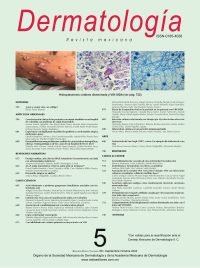Dermatofibrosarcoma protuberans: Analysis of demographic, clinical and histopathological characteristics of the cases of a third-level hospital.
Dermatol Rev Mex. 2024; 68 (5): 609-614. https://doi.org/10.24245/drm/bmu.v68i5.10046
Daniela Ruíz Gómez,1 Landy Hayde López Jiménez,2 Emilio Peniche Luna,3 Sonia Toussaint Caire,1 Verónica Fonte Ávalos,1 María Elisa Vega Memije1
1 División de Dermatología,Hospital General Dr. Manuel Gea González, Ciudad de México.
2 Fundación Clínica Médica Sur, Ciudad de México.
3 Facultad de Medicina, Universidad Nacional Autónoma de México.
Resumen
OBJETIVO: Describir las características clínicas e histopatológicas de la población con dermatofibrosarcoma protuberans, así como el tratamiento recibido.
MATERIALES Y MÉTODOS: Estudio observacional, retrospectivo, efectuado en el Hospital General Dr. Manuel Gea González, Ciudad de México, de enero de 2001 a mayo de 2023. Se incluyeron los pacientes con diagnóstico de dermatofibrosarcoma protuberans con una historia clínica disponible. Se consideraron las variables: sexo, edad, topografía, tamaño del tumor, diagnósticos diferenciales, características histológicas y tratamiento.
RESULTADOS: Se incluyeron 23 pacientes, 17 eran mujeres, con edad media de aparición de 39 años e incidencia mayor en el grupo de 31 a 50 años (10/23). El tronco fue el sitio más afectado (12/23), 14 tumores medían menos de 5 cm, con tiempo medio de evolución de 6 años. De los subtipos histológicos de dermatofibrosarcoma protuberans, la forma clásica se reportó en 18 pacientes. Se tomó biopsia diagnóstica y se refirió a un centro oncológico a 10 pacientes y también en 10 se practicó la escisión con márgenes amplios (1-2 cm).
CONCLUSIONES: El dermatofibrosarcoma protuberans afecta predominantemente a personas adultas; sin embargo, también puede manifestarse en población pediátrica. Tiene una clínica indolente y heterogénea que dificulta la sospecha diagnóstica por médicos de primer contacto, lo que condiciona un diagnóstico tardío con repercusión en la morbilidad del paciente.
PALABRAS CLAVE: Dermatofibrosarcoma; dermatofibrosarcoma protuberans; tumor fibrohistiocítico; tumor de tejidos blandos; cirugía micrográfica de Mohs; tumor de Bednar.
Abstract
OBJECTIVE: To describe the main clinical and histological characteristics of the population with dermatofibrosarcoma protuberans, as well as treatment.
MATERIALS AND METHODS: A retrospective cohort-type observational study was done at General Hospital Dr. Manuel Gea Gonzalez, Mexico City, from January 2001 to May 2023. The patients with a diagnosis of dermatofibrosarcoma protuberans with an available medical history were included. For the present protocol, a broad category of variables were considered: sex, age, topography, tumor size, differential diagnoses, histopathologic characteristics and treatment.
RESULTS: Twenty-three patients were registered, 17 were women, in a female-male ratio of 2.8:1. The mean age of presentation was 39 years, with a higher incidence in the group of 31 and 50 years (10/23). With respect to location, it was observed that the trunk was the most affected site (12/23); as to size, 14 cases were reported with a size lesser than 5 cm. Regarding the histological subtypes of dermatofibrosarcoma protuberans, the classic form was reported in 18 patients. A diagnostic biopsy was performed, and 10 patients were referred to an oncology center. Similarly, excision with wide margins (1-2 cm) was carried out in 10 patients.
CONCLUSIONS: Dermatofibrosarcoma protuberans predominantly affects adults; however, it also affects the pediatric population. It presents with an indolent and heterogeneous clinical profile, making it challenging for primary care physicians to suspect, leading to a delayed diagnosis with an impact on patient morbidity.
KEYWORDS: Dermatofibrosarcoma; Dermatofibrosarcoma protuberans; Fibrohistiocytic tumor; Soft tissue tumor; Mohs micrographic surgery; Bednar tumor.
Recibido: febrero 2024
Aceptado: junio 2024
Este artículo debe citarse como: Ruíz-Gómez D, López-Jiménez LH, Peniche-Luna E, Toussaint-Caire S, Fonte-Ávalos V, Vega-Memije ME. Dermatofibrosarcoma protuberans: análisis de características demográficas, clínicas e histopatológicas de los casos de un hospital de tercer nivel. Dermatol Rev Mex 2024; 68 (5): 609-614.

